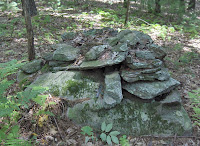 I'm currently reading a borrowed copy of Exploring Stone Walls, by Robert M. Thorson (New York, Walker & Company, 2005), a book supplemented by this webpage: http://stonewall.uconn.edu/ExploringStoneWalls.htm.
I'm currently reading a borrowed copy of Exploring Stone Walls, by Robert M. Thorson (New York, Walker & Company, 2005), a book supplemented by this webpage: http://stonewall.uconn.edu/ExploringStoneWalls.htm.In particular:
"•Stone Wall Science http://stonewall.uconn.edu/ExploringSWTerms.htm. This list of terms can be used to describe stone walls scientifically.
•Classification systems for stone Concentrations, Rows, and Notable Stones http://stonewall.uconn.edu/Classification.htm. These were not included in Chapter 9 - Classification for lack of space.
•A hierarchical list of the Complete Stone Wall Taxa http://stonewall.uconn.edu/ClassificationTaxa.htm for the more serious stone wall scientist. This is the whole taxonmy, using labels only ("Oh really?" - Tim).
•A printable version of stone wall science is List of key terms (.doc) used in the book arranged by category. If you have the book, use the index to locate where they are defined. "
I took a Rock Piles Post (Jacob Gates Lane Conservation Land, Harvard MA from Sept. 12, 2006) of a "stone concentration" and applied the above to it, plus my additional terms:
Condition (damaged or undamaged etc.): Well Preserved (8 on scale 1-10?)
Degree of order (stacked, dumped, or laid, etc.): Artistic
 Stone topography (boulder, slab, chunky): all of the above, as well as my additional descriptive terms, Testudinate; Carapace Stone Type: Scutes of Stone. Head, (Out stretched ) Forelegs, and Plastron.
Stone topography (boulder, slab, chunky): all of the above, as well as my additional descriptive terms, Testudinate; Carapace Stone Type: Scutes of Stone. Head, (Out stretched ) Forelegs, and Plastron.Function (foundation, retaining, etc.): Sacred – Turtle Clan Effigy, Ceremonial, Memorial, and other possibilities.
4 comments :
RANTING: I cannot tell what you are making fun of and what is being taken seriously. I recently decided simple taxonomical classifications do not really work. If I had to identify a key reason, aside from observer naivete, it would be this: features ("taxonomy") of individual structures need to be taken in the context of the other structures and site characteristics where the structures appear. That then needs to be taken in the context of many different sites - so that consistent site-to-site concepts emerge and local variations with no significance are ignored. In the end, a detailed taxonomy of individual/isolated structures such as you describe, without local or regional context, runs the risk of distracting from the actual significant similarities and differences.
On the other hand one might argue that this taxonomical classification never tried, nor pretended, to give insight into cultural and functional differences between different stone walls. (The kind of insight I am looking for, for rock piles.) For example, being made from fieldstone might or might not be of any interest. My sense is it does not have much to do with culture and, functionally, relates to what kind of rock is available. In other words: so what?
But then I am probably just being bitchy cuz I gather Thorson does not "get" rock piles; and he does not suspect stone walls might have been made by Indians, or that walls might be pre-contact. If so, it would not be surprising that his work is still at the stage of observer naivete. Yes, this is bitchy but then: staking out an academic territory of stone walls, while ignoring rock piles and ignoring what is likely the actual history of such things, consitutes a threat in various ways. So I think it should be said loud and clear: such classications are naive.
I guess I can't take seriously what others take seriously - like Euro-centric bigotry or will-full ignorance or the more kind "observer naivete."
On Page 95, Thorson wrote: "The self published literature is replete with millenium old walls, which may very well exist. Unfortunately, none have yet been verified by physical evidence supported by peer-reviewed scientific studies with radio carbon dates or unambigous associations." By page 96 he states "The pre-European stage (before 1620) was characterized by the absence of stone walls. There were, however, specific stone structures, including monuments, weirs, local storage facilities, and burial mounds." Elsewhere he dissmisses burial mounds (etc.) as "tossed" heaps of stone.
I'm about to get started on what he calls "rare zigzag traces..."
where is that amazing turtle?
Keith
I tried to get Thorson to visit what I considered to be pre-colonial stone features in Montville, CT, but for one reason or another he we never got together. Then I found out that his idea that the Indians had no stone building technology came directly from Nick Bellantoni, and both teach at UConn. When Thorson says on p. 95 of his book "Exploring Stone Walls" that none of the presumed pre-colonial walls have been verified by radiocarbon dating, he apparently did not see the evidence supplied by Jim Whittall, when he dated the stone row partially surrounding the Morrill Point Mound in Massachusetts by C14 analysis to pre-900 AD. This is also caught on video by Timreck in his DVD "The New Antiquarians." Archaeologists in the know believe that Whittall's excavation of the Morrill Point Mound was professional in nature.
Post a Comment